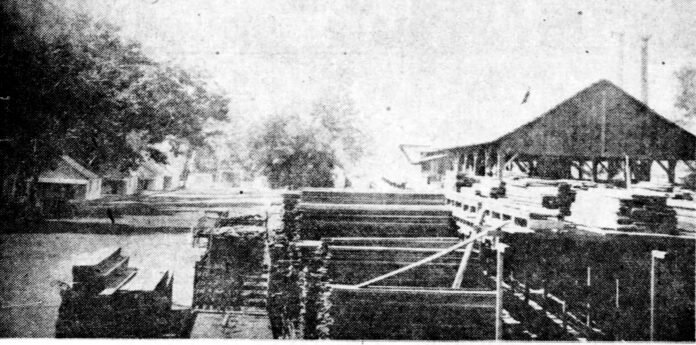1887. From the porch of “Hillside,” his aptly-named summer estate, timber baron James P. Pierce could literally oversee his domain. Away to the north were redwood-covered slopes, awaiting harvest. In the foreground, just across the San Lorenzo River, was the site of his new Pacific Mill, a railroad station, and what one visitor referred to as “quite a little village.”
Pierce had made a fortune washing gold off hillsides with powerful hoses. After investing in the San Lorenzo flume and railroad in the 1870s, he purchased 2000 acres of uncut timberland in the heart of the valley. The original Pacific Mill at the mouth of Love Creek worked up lumber along the river to what is now Glen Arbor, relying on the flume for transportation. When the Felton and Pescadero railroad was completed in 1885, Pierce quickly recognized a different opportunity for profit and relocated his operation across the river.
The new Pacific Mill was thoroughly up-to-date, containing machinery for the manufacture of all sorts of finished lumber. In addition to the usual circular saws, it housed a band saw, the first in the area, allowing finer processing. “Every part of the log is worked up and nothing wasted,” the Pacific Rural Press reported in 1887, “Even all the spare sawdust is sold to a San Jose brewery at $25 a carload. More could be sold there, but it is used at the mill to fire the boilers.”
The water of San Lorenzo was also utilized, brought into a large mill pond on the low ground where the river looped around the site. “A dam is being built, noted a reporter, “and a pond constructed where the logs will be floated for more convenient selection before sawing. A railway is in process of construction…on both sides of the pond, where the logs will be unloaded directly into the water.”
Although there had been sawmills in the area since pioneer days, much of the old-growth forest on the difficult local slopes had survived. Pierce’s lumber-cutting campaign relied on transportation. The railroad depot became a hub that linked the new bridges to the surrounding region and the spur tracks that led to the sawmill. In cooperation with the Ben Lomond Wine Company, located on Empire Grade, what is now called Alba Road was cleared and graded, providing access to the trees on the side of Ben Lomond Mountain. On the other side of the river, the timber in the upper reaches of Love Creek would be taken out by his company’s own train, running three miles up its corporate track.
To support the mill and its workforce, Pierce and his superintendant, Thomas L. Bell, provided a variety of other buildings on the river bank across from the mill — a general store, warehouses for grain and hay, a boarding house for the men, cottages for families and a large amount of stabling. “The finest of water” was brought in from Marshall’s creek, through over 1500 feet of pipe.
More than the usual amenities were provided. The company store offered both telegraph and telephone service and a Wells Fargo Express office. “The Post Office, “observed the Santa Cruz Surf, “will doubtless be established in the same place.” This prediction proved true in April 1887. Federal authorities, however, rejected the name “Pacific Mills,” so the appellation “Ben Lomond” was borrowed from the nearby mountain and winery.
While train and mill whistles signaled a rush of industrial activity, Pierce planned a different sort of future for Ben Lomond as a place “of residence and resort.” His ideas were up-scale — this was not to be a “stump town” like Boulder Creek. His own residence, “Hillside,” which featured a large reception room and a “baronial” fireplace, was designed to convince other affluent businessmen to move to the neighborhood.
In the fall of 1887, the land around the mill and railroad depot was subdivided into town lots. The Sentinel approved, noting that “Mr. Pierce, by these sales, is proving himself a benefactor to the neighborhood – new people are moving to that locality, houses are being erected, homes established, grounds cultivated, orchards set out and a population of sterling, thrifty citizens secured.”
To further the goal of attracting high-class summer visitors, Pierce and Bell planned a luxurious resort. “One of the prettiest locations in the village,” advertised the Surf, “has been reserved for a hotel site. It is a roomy, wooded knoll, sloping downward to the San Lorenzo on one side, quite convenient to its railroad station and commanding picturesque mountain and valley views.” The site would also feature “an abundance of water.”
(To Be Continued)
Randall C. Brown is a local historian and is a member of the San Lorenzo Valley Board of Directors













